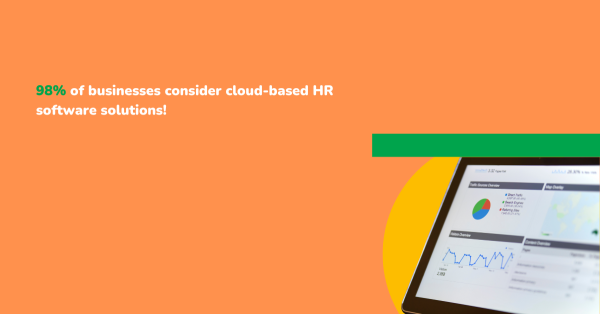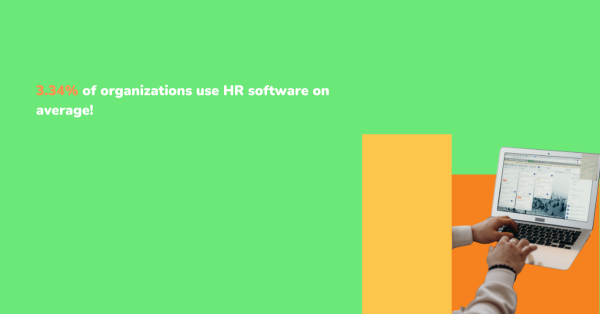The way you manage your workforce can either drive your organization forward or quietly hold it back. Traditional HR methods, reliant on spreadsheets, fragmented systems, and manual tracking, are no longer equipped to meet the expectations of modern organizations or employees. You’re expected to deliver more agility, more transparency, and more data-driven decisions, all while ensuring compliance and maintaining a strong company culture.
As businesses grow in complexity, so does the demand on your HR function. You’re not just overseeing hiring or handling payroll anymore. Your role is central to shaping employee experiences, supporting strategic decisions, and making sure that people-related operations are aligned with larger business goals. In fact, 57% of HR professionals report working beyond normal capacity, highlighting just how overwhelming these responsibilities can become. But doing that effectively with outdated processes or disconnected systems? That’s an uphill battle you shouldn’t have to fight.
The shift toward digital transformation is no longer optional. It’s the difference between simply keeping up and moving ahead, with 56% of HR leaders confirming the need for new HR technology. If you’re still relying on tools that weren’t built for today’s challenges, you risk missing out on insights, losing valuable time, and creating friction in the employee experience. What you need is a smarter, unified approach, something that helps you simplify day-to-day processes while enabling deeper strategic impact.
This is where human resource management software steps in. It’s not just about automation, it’s about equipping you with the right tools to manage, engage, and empower your workforce efficiently. Whether it’s organizing employee data, tracking performance, or improving internal workflows, smarter HR tools lay the foundation for long-term success.
What Is Human Resource Management Software?
When you’re responsible for overseeing the entire employee lifecycle, from recruitment to retirement, you need more than a few spreadsheets and isolated tools. You need a system that centralizes, simplifies, and enhances every aspect of workforce management. That’s where a human resource management system comes in.
So, what is human resource management software? At its core, it’s an integrated digital platform designed to handle a wide range of HR activities within a single interface. It brings together all your core HR functions, such as employee records, time tracking, benefits administration, performance monitoring, and compliance, into one cohesive environment. Instead of jumping between applications or manually inputting data, you’re working with a streamlined solution that improves consistency and reduces the administrative burden.
This type of software is built to empower you with structure and flexibility. You can configure workflows, automate repetitive tasks, and ensure that processes are both accurate and compliant. It reduces the room for human error and ensures that your HR operations run smoothly even as your team or organization scales. The most common motivation for deploying a system in firms of all sizes is to acquire more functionality, with over 25% of companies indicating this as their primary purpose for implementing an HRMS. Whether it’s onboarding a new hire, managing leave requests, or setting up appraisals, you gain full visibility and control, all from a centralized platform.
Beyond operational support, this kind of software provides the framework you need to make better decisions. With data centralized and accessible, you can easily analyze trends, generate reports, and identify areas for improvement. You no longer have to rely on guesswork or outdated records. Instead, you have real-time access to the insights that matter most to your team and your leadership.
And it’s not just about functionality, it’s about connectivity. A modern employee management software solution should integrate seamlessly with other systems your organization uses, from payroll to communication tools. This connectivity ensures a smoother experience not just for you, but for everyone in the company who interacts with HR.
Ultimately, HR software gives you the power to do more with less effort. It turns routine HR functions into strategic tools, so you can focus on what really matters, your people. By implementing a comprehensive platform, you’re not only increasing efficiency but also contributing directly to the success and agility of your organization.
Core Features That Drive Efficiency

To effectively manage your workforce, you need a solution that covers a broad range of functions without creating additional complexity. This is exactly what HRMS features aim to deliver, comprehensive tools that streamline your daily HR activities while providing valuable insights. When you implement the right system, you’re equipped to handle essential tasks more efficiently and with greater accuracy.
One of the fundamental features you’ll rely on is centralized employee data management. This allows you to keep all critical information, such as personal details, job history, and compliance documents, in one secure location. In fact, 50% of companies were seeking core HR functionalities when shortlisting HR software. With this data at your fingertips, you can quickly access what you need without wasting time searching through disparate files or systems.
Time and attendance tracking is another key feature that simplifies the process of monitoring work hours, managing shifts, and handling absence requests. Instead of manually compiling timesheets or chasing down approvals, automation lets you ensure accuracy and maintain compliance effortlessly. This feature alone can save you countless hours each month and reduce errors that might otherwise impact payroll or labor law adherence.
Leave/PTO or absence management also plays a vital role. By offering a self-service portal where employees can request time off and view their balances, you reduce administrative overhead while improving transparency. You stay informed about staffing levels and can plan accordingly, avoiding surprises that disrupt business operations.
Recruitment and onboarding modules are essential for attracting and welcoming new talent. These features help you manage job postings, track applicants, and onboard new hires efficiently, all while maintaining consistency and compliance with HR software, with onboarding tools reducing onboarding time by 80%. Automated workflows and digital checklists make the process seamless, ensuring nothing falls through the cracks.
Performance management tools support ongoing development and alignment by enabling goal setting, continuous feedback, and evaluations. You gain a clear picture of employee progress and can address challenges proactively. This promotes engagement and growth without adding complexity to your workload. This is highlighted by the statistic that a performance management solution can save up to 180 hours in the feedback process.
Reporting and analytics capabilities provide you with real-time insights into workforce trends, productivity, and compliance. Instead of waiting for monthly or quarterly reports, you have instant access to data that supports better decision-making. Customizable dashboards let you focus on the metrics that matter most to your organization.
A well-rounded HR system is designed to work cohesively, meaning these features don’t operate in isolation. They integrate seamlessly, allowing you to create workflows that reflect your unique business needs. This connectivity enhances user experience, reduces duplication, and ensures your HR processes are efficient from end to end.
By utilizing these core features, you transform HR from a reactive function to a proactive strategic partner. You spend less time on administrative tasks and more time focusing on initiatives that drive business success.
Why Human Resource Software Is Crucial for Growing Businesses
As your organization expands, the demands on your HR function multiply. You’re not just managing more employees, you’re navigating increasingly complex workflows, regulatory requirements, and workforce expectations. This is why investing in the right human resource software is essential to keeping pace and sustaining growth.
When you rely on outdated or fragmented systems, you risk inefficiencies that can slow down your entire operation. Manual processes can lead to errors, missed deadlines, and a lack of clear visibility into your workforce data. This creates bottlenecks that make it difficult to respond quickly to changes or opportunities. By contrast, a modern human resource management system streamlines your day-to-day work, freeing you to focus on strategic priorities.
Automation plays a key role in this transformation. With the right system in place, repetitive administrative tasks, such as data entry, leave approvals, and performance tracking, are handled automatically. This reduces the chance of mistakes and eliminates time-consuming manual work. As a result, you can devote more energy to initiatives that directly support business goals.
Compliance is another critical factor. Employment laws and regulations evolve constantly, and staying up to date is a major challenge. An HRMS helps you maintain compliance by automating record-keeping, managing certifications, and generating audit-ready reports. This minimizes risk and ensures you’re prepared for any inspections or legal reviews.
Scalability is often overlooked, but it’s a fundamental reason why human resource software is vital for growth. As your headcount increases or your organizational structure becomes more complex, you need a system that adapts with you. The flexibility to add new modules, integrate with other platforms, and customize workflows means your HR technology won’t become a roadblock as you scale.
Additionally, centralized data management improves your ability to make informed decisions. Instead of sifting through multiple sources or relying on intuition, you have access to real-time insights about turnover rates, employee engagement, and workforce productivity. This empowers you to identify trends early and implement targeted solutions.
The employee experience also benefits when you use a comprehensive human resource management system. Self-service portals enable your team to manage their own information, submit requests, and track progress, reducing their dependency on HR and improving satisfaction. A smoother HR experience strengthens retention and attracts top talent.
Ultimately, human resource software is not just a tool for managing people, it’s a strategic asset that supports your business as it evolves. By investing in the right system, you position yourself to handle growth with confidence and agility, ensuring your HR function contributes meaningfully to overall success.
Comparing Human Resource Management Systems: What to Look For

Choosing the right HRMS can feel overwhelming. With so many options available, it’s important to focus on what truly matters to your organization and its unique needs. When evaluating different systems, you’ll want to look beyond just features and pricing and consider factors that will impact usability, scalability, and long-term value.
First and foremost, ease of use is critical. You need a platform that you and your team can navigate effortlessly. A complex or unintuitive interface will slow down adoption and limit the benefits you can gain. Look for software that offers a clean design, straightforward navigation, and accessible support resources. The goal is to minimize training time and maximize productivity from day one.
Integration capabilities should be a top consideration as well. Your human resource management system will rarely exist in isolation. It should seamlessly connect with your payroll, benefits administration, and communication tools, among others. This interoperability ensures smooth data flow and prevents the duplication of effort across different departments or software.
Customization is another key factor. Every organization has its own processes, policies, and reporting needs. The best systems allow you to tailor workflows, forms, and dashboards to fit your specific requirements. This flexibility helps you avoid one-size-fits-all limitations and makes the software an actual extension of your HR team.
Security cannot be overlooked. You’re handling sensitive employee data, and protecting that information must be a priority. Evaluate the system’s data encryption methods, access controls, and compliance with privacy regulations. A trustworthy vendor will be transparent about their security protocols and offer regular updates to address emerging threats.
Mobile accessibility is increasingly important, especially as remote and hybrid work arrangements become more common. You should be able to manage core HR functions from a smartphone or tablet, whether approving leave requests, reviewing reports, or communicating with employees. In fact, 72.21% of companies preferred cloud-based HR software, which often includes responsive mobile apps or web portals that enhance convenience and keep you connected regardless of location.
Another element to consider is reporting and analytics capabilities. You want a system that goes beyond basic data storage and provides meaningful insights. Look for customizable reports, real-time dashboards, and tools that allow you to track key HR metrics easily. These insights will empower you to make informed decisions and demonstrate HR’s impact on stakeholders.
Vendor reputation and support services also play a vital role. Choose a provider known for reliability, responsiveness, and ongoing innovation. Strong customer support ensures you won’t be left stranded if challenges arise and that you benefit from continuous improvements.
Finally, cost is always a factor, but it should be weighed against the value delivered. Look for transparent pricing models that align with your budget and growth plans. Remember that the cheapest option may not be the best in the long run if it lacks essential features or scalability.
By keeping these criteria in mind, you’ll be better equipped to select a HR system that not only meets your current needs but also supports your organization’s future ambitions.
Common Mistakes to Avoid When Choosing Human Resource Management Software
When selecting an HR system, it’s easy to get caught up in features or pricing and overlook important factors that can affect long-term success. Avoiding common pitfalls will help you choose a solution that truly supports your HR goals and grows with your organization.
One of the biggest mistakes is failing to clearly define your needs before starting the search. Without a solid understanding of your current challenges and desired outcomes, you risk investing in software that doesn’t fully address your priorities. Take the time to map out essential functions, user requirements, and integration needs so that your choice aligns with real-world demands.
Another frequent error is focusing solely on upfront costs without considering the total cost of ownership. Cheap software might seem appealing at first, but hidden fees, expensive upgrades, or costly add-ons can quickly increase your expenses. Additionally, a low-cost system that lacks critical features or scalability may lead to switching vendors prematurely, which is disruptive and costly.
Overlooking user experience is also a common problem. A system loaded with features but difficult to use can slow adoption and frustrate your team. Choose software that is intuitive and offers training and support resources. The easier it is for your HR team and employees to engage with the platform, the more value you’ll gain.
Ignoring the importance of vendor support is another mistake to watch for. Even the best software needs ongoing assistance, updates, and troubleshooting. A vendor that provides poor customer service or lacks a clear roadmap for product improvements can leave you stuck with outdated tools.
Failing to prioritize security and compliance can expose your organization to risk. Ensure the software complies with relevant data protection laws and includes robust security features to safeguard sensitive employee information. Neglecting this aspect could result in costly breaches or legal issues.
Another oversight is not testing the software thoroughly before full implementation. Skipping or rushing pilot phases might lead to discovering issues too late, causing operational disruptions. Engage your HR team in testing to confirm the system fits your workflows and expectations.
Finally, not considering future growth can limit your options down the road. Your human resource software should be scalable and flexible enough to adapt as your organization evolves. Avoid solutions that can’t grow with you, as this may force premature and costly changes.
By steering clear of these mistakes, you can select a HRMS that enhances efficiency, supports compliance, and empowers your workforce for years to come.
Why OrangeHRM?
When it comes to choosing a HR system, you need a solution that is reliable, comprehensive, and easy to use. OrangeHRM is designed to meet all of your HR needs in one powerful platform. Whether you’re managing employee information, tracking time and attendance, or driving performance management, OrangeHRM offers a flexible and scalable system tailored to support your organization’s growth.
Equipped with intuitive tools and customizable features, OrangeHRM helps you automate routine tasks, maintain compliance, and gain valuable insights, all while improving the employee experience. Its user-friendly interface ensures smooth adoption across your HR team and workforce, making your daily operations more efficient. Ready to see how OrangeHRM can transform your HR function? Book a FREE demo today and discover the difference a smart HRMS can make for your organization.
